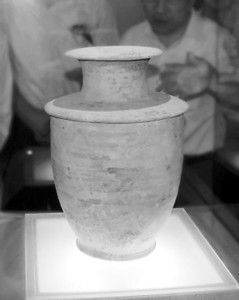Centre of Shanghai at Qingpu in 4000 Years Ago –New Evidence from Archaeological Discoveries at the Fuquanshan Site
The Archaeology Department of the Shanghai Administration of Culture Heritage has conducted an excavation at the Fuquanshan site, with 91 delicate artefacts retrieved. The site is located at the western side of Zhonggu Town in Qingpu district. It is one of the prominent prehistoric sites in Shanghai and the Lake Tai region. The site was announced to be the State-protected major historical and cultural monuments by the State Council in 2001. Large scale scientific excavations were conduced at the site during the 1980s and a series of fruitful result in view of archaeology were attained.

In order to fully understand the distribution of the site in terms of its cultural deposits in various periods, archaeological survey using test trenches was conducted outside the Fuquanshan earth mount by the Archaeology Department of Shanghai Administration of Culture Heritage from mid December 2008. 16 test trenches were opened and the actual excavated area was around 303.6㎡. The most important result of this survey was the artificial platform and the gigantic tombs for nobles of the late Liangzhu culture. Besides, cultural deposits of prehistoric Majiabang, Songze and Maqiao cultures and historical period Zhou, Jin, Tang, Song and Yuan dynasties were also found.

This is the first time high rank noble tombs of the late Liangzhu Culture was discovered near the outer boundary of the Fuquanshan and it is meaningful in studying the distribution of Liangzhu Culture deposits at the site. The burial style of this tomb was unique with copious amount of burial items, which was rarely seen in the past excavations on Liangzhu Culture. Burial M204 unearthed 9 jade items and exceeded the number of previous excavation at centre of the Fuquanshan site. A huge jade disc of 26.4 cm in diameter, which was bigger than the previous one discovered at this site for 0.4 cm, reflect the elegancy of the tomb. There was a jade awl with 40 cm long, also longer than the previous jade awls of the site. A jade cong inscribed with deity and bird pattern was similar to the cong shape bracelet found in the central area of the site. Theses findings are valuable for the researches on indigenous people worshipping totem and jade manufacture.
This excavation is not only the greatest discovery in site of Fuquanshan since the 1980s, but also a new breakthrough for the Liangzhu Culture, which will influence the field of archaeology. More importantly, this excavation provides profound knowledge for studying of the function of Fuquanshan site.
(Translated by Li Langlin)

